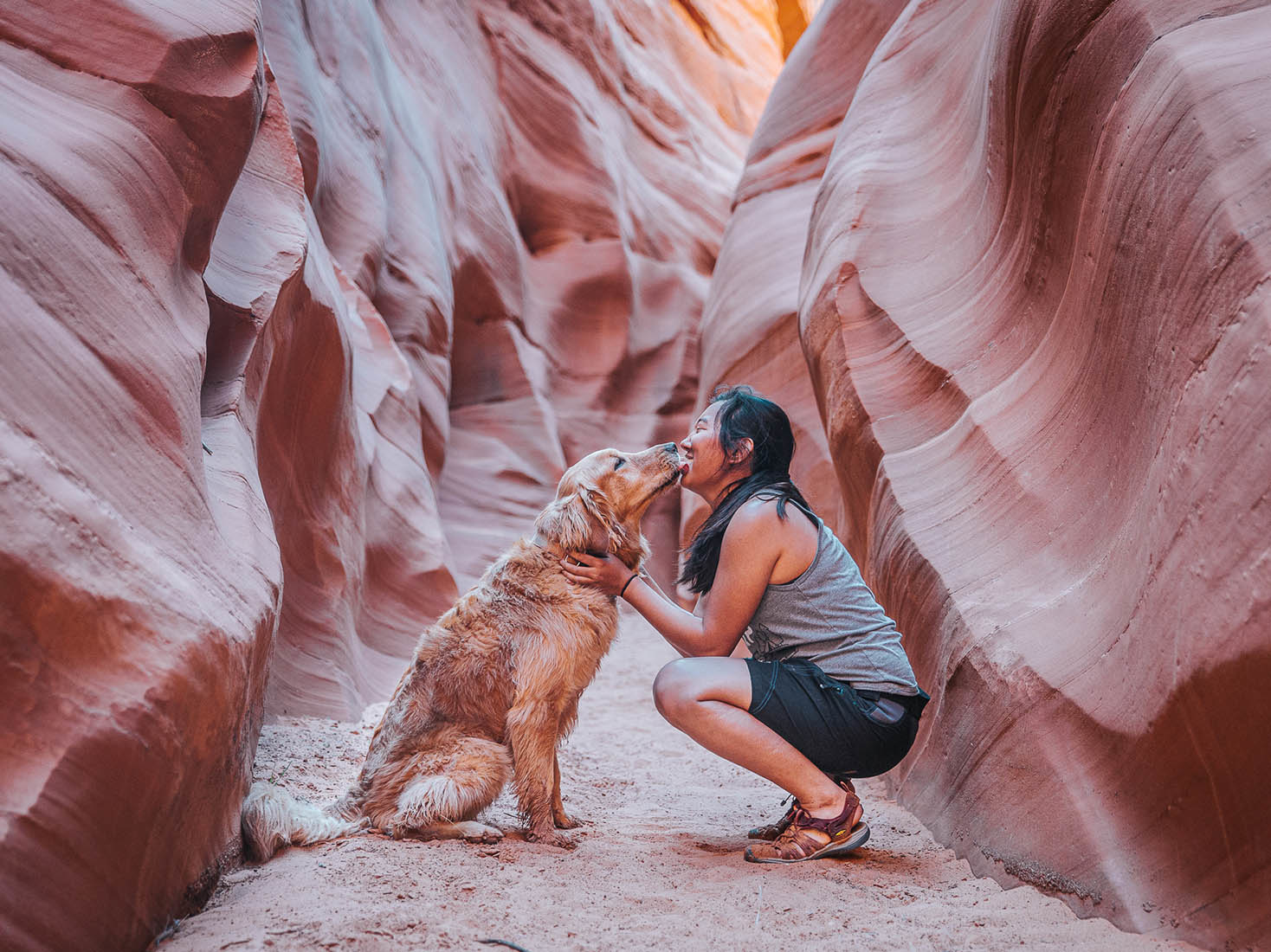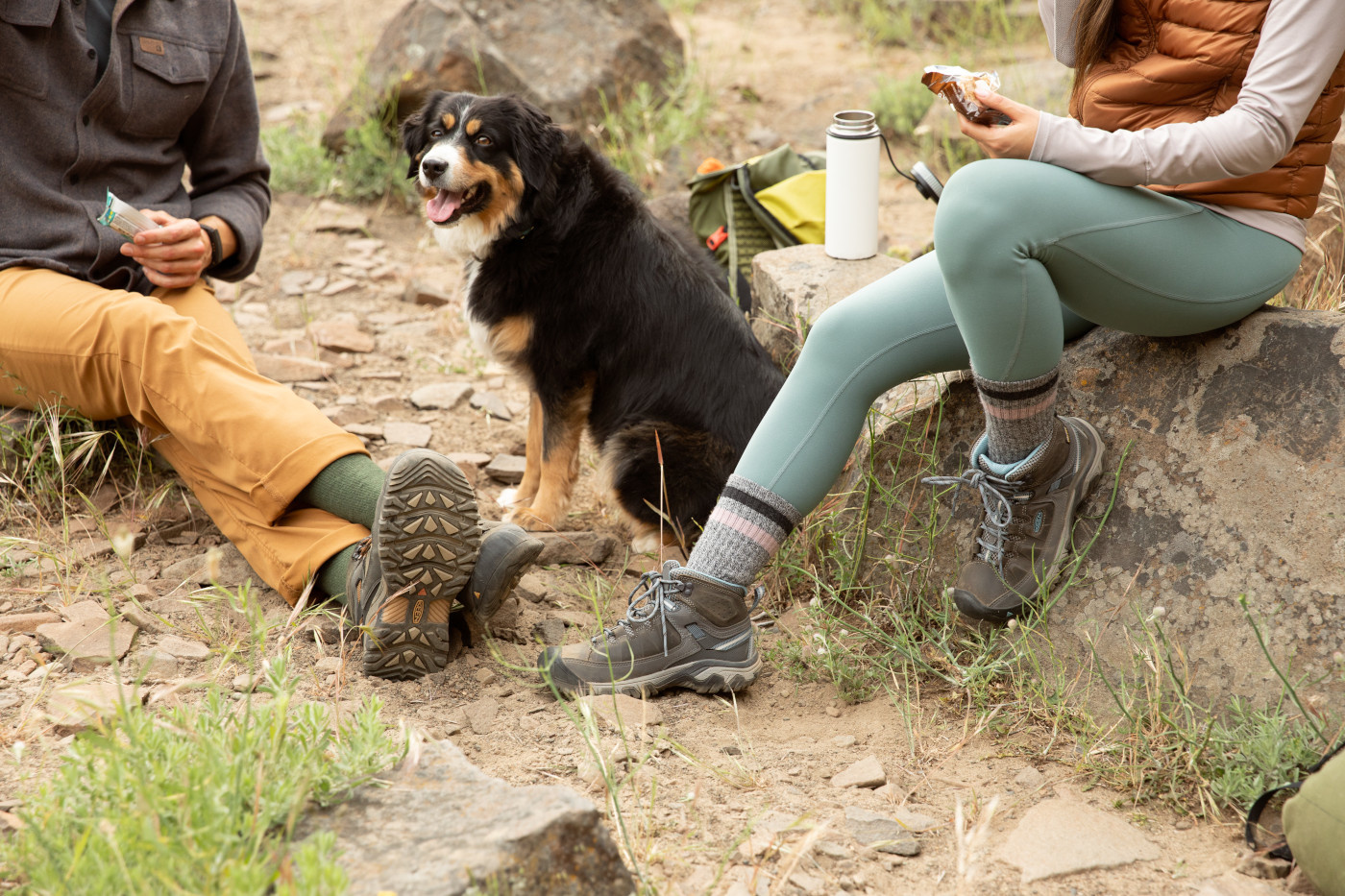1. FIND DOG-FRIENDLY TRAILS
According to the American Hiking Society, there are over 193,500 miles of federally managed trails in the United States. Now that’s a lot of ground to cover! But before you start planning to hit the trail with your four-legged buddy, make sure to do a little research to determine if dogs are welcome in the area you have in mind. Different areas have different guidelines, and you’ll want to read up on them so you show up prepared (and don’t disappoint your sweet pooch when you have to head back home early).
2. ALWAYS BE PREPARED TO LEASH UP
Even if you’re hiking in an area that doesn’t require your dog to be leashed, make sure you have one on hand (and not buried in your bag)! After all . . . it’s nature. You just never know when you might encounter a little family of bears or a steep cliff edge that you’d like to safeguard your dog from. Keep in mind that even if you trust your dog, other people's dogs can be unpredictable and that leashing up when you encounter other pups can help to alleviate trail tensions. Pro tip: a 6-foot leash is the perfect length to loop up and wear across your body as you hike.
3. PACK THE ESSENTIALS
(AND A FEW EXTRA TREATS FOR GOOD BOYS AND GIRLS)
Just like you wouldn’t leave the house for a hike without the right gear, make sure your dog has his gear too. We recommend the following equipment for all trail doggos:
A collar or harness: Always make sure your dog is wearing a collar or body harness with a name tag that lists a contact phone number. Attaching a bear bell can also be handy should you encounter any wildlife that tends to steer clear of approaching noises (like mountain lions and bears). Need a new collar or leash for your upcoming outdoor escapades? Check out our KEEN dog collars and leashes if your pup could use a fresh look. Plus they’re made out of recycled plastic bottles for a durable design that’s good for the Earth too. (Look how excited this sweet pup is about her new wardrobe!?)

Water: It sounds like a no-brainer, but you’d be surprised how many times we’ve come across owners (and dogs) on the trail who didn’t bring enough water. It’s recommended that you bring at least eight ounces of water per hour of hiking and increase the amount if the conditions are warm or the hike is fast-paced. Be aware that streams and lakes can harbor microscopic organisms, like giardia, that can make your pup sick.
A dog first aid kit: Trekking across a shale ridge or brushing against a tick-covered plant, you’ve got to be prepared for the unknowns. That’s why it’s important to have a first aid kit handy. You can either add a few dog specific items to your human first aid kit or create one specifically for your pup. A basic kit should include items for wound care such as sterile bandages, hydrogen peroxide, antiseptic wipes, and triple antibiotic ointment, as well as tools like a tick key, tweezers, and small irrigation syringe. Throw in a few packets of Antihistamine and a reference guide on pet first aid, and be on your way.
Packable harness for backcountry adventures: Should your dog become injured and unable to hike out, these harnesses allow you to securely carry your dog on your back. You can purchase one or make your own using a ratchet strap or nylon webbing. Regardless of which type you choose, be sure to do your research to ensure you get the right one for your size dog and that you learn how to attach the harness or strap properly.
4. DON’T FORGET TO TRAIN
And we don’t mean sit, stay, and rollover (although those are great too). We mean, start with small outings and work up to that big backpacking trip. Sure, dogs are pretty durable, but taking them from days at home sleeping on the couch (you know they do it when you’re not around) to a 25-mile overnighter is going to be too much. Start out with short day hikes and add miles and difficult terrain as your dog gets stronger. Training gives their joints and paw pads a chance to adjust from urban sidewalks to the rocks and roots of the trail. Know your dog's limits and remember to take breaks. Once your dog graduates to the big trails, consider treating them to an adventure of a lifetime like KEEN fan Hana Kim did with her dogs in Antelope Canyon.

Think maybe your dog is trained up but you still need a little more trail time before a big trip? Check out some of our favorite KEEN shoes for urban and wooded hikes. Our women’s Terradora Shoes and Boots and men’s Feldberg Boots are comfortable hikers that offer supportive cushioning, durability, and traction (all in a sleek, casual package).
5. ALWAYS PACK IT OUT
And we mean always. Contrary to what many people believe, dog poo is just really different from the scat of bears, deer, and Mr. Bunny Foo Foo that live full-time in the woods. A report put out by Leave No Trace suggests that while wildlife waste benefits the ecosystem, dog waste contributes bacteria and excess nutrients that throw off the natural balance of things out there. So remember to bring along some poo bags (and some extra bags while you’re at it in case you see other piles that owners may have. . . ahem . . . missed).
6. MUDDY PAWS HAPPEN!
We like to keep a towel in our car for a wipe down before heading home. Handy for us two-legged hikers after stream crossings and rainy hikes, too.
After a day in the woods with your dog, you may find yourself dreaming of your next adventure together. Or, you may find yourself removing ticks from their rear end with a strange looking tool you’ve never used before. Either way, your pup is sure to thank you with some loving licks and a quiet evening (since they’ll be so tired and happy from your time together in the woods). Good dog.



Leave a comment